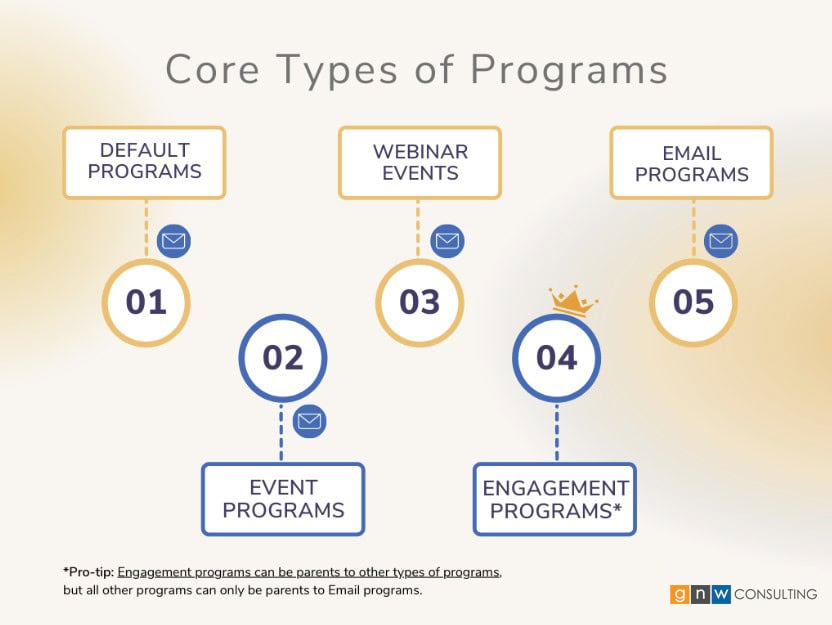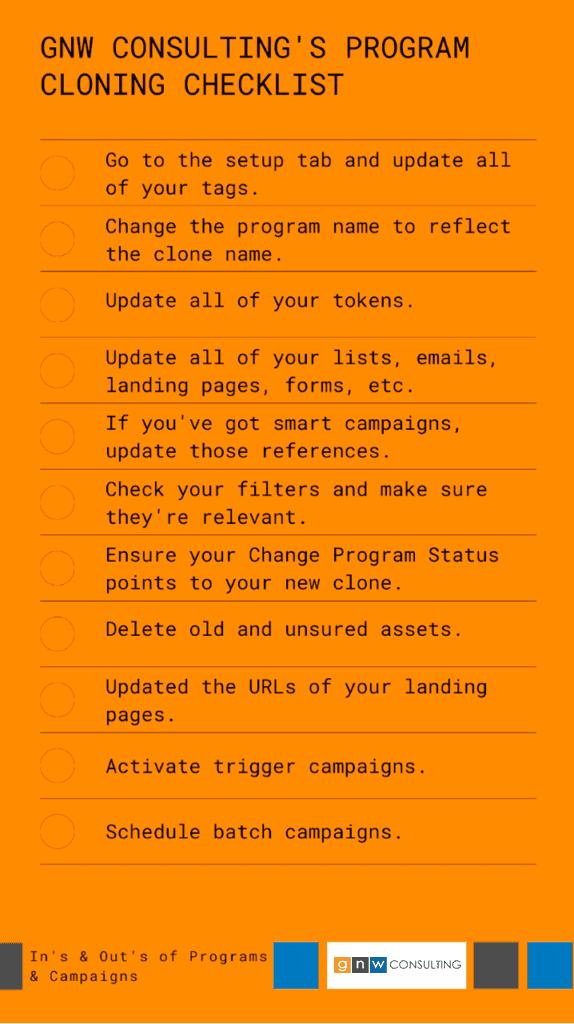Marketing Automation is a great way to automate everyday marketing activities to ensure overall business growth, but one of the most popular questions we get is ‘will automated campaigns really drive the results we need?” The short answer is yes, but the long answer, well, that depends on how you leverage automation.
While each platform has it’s own form of “program types” you can think of these as the core foundations of your campaign – a program type is the foundation, the home is the campaign, everything inside are your assets. Essentially, it’s a “container” for all your marketing initiatives and each campaign lives in a separate program that helps keep everything organized. We stress the fact that you should keep everything organized, but that’s easier said than done. It’s why we’ve put together this quick guide to help you on your journey and hopefully find new ways to save time setting up your next campaign. Here’s what you can expect:
Program Types to Know
Programs contain everything. They’re a home for your creative assets and campaigns. As we mentioned earlier, a best practice to follow is to ensure every single campaign lives in a separate program. This will allow you more flexibility and grant you the ability to clone. Yes, clone, is easily one of our favorite pro-trips and a time saver that’s always bound to save you in trying times.
Programs can also house marketing automation tasks, such as field updates, record management, lead scoring and more. You can also leverage the power of list building to feed your programs into each other. Don’t worry, it seems complicated, but we’ll explain.
Finding the Right Use Case
So, how do you plan ahead and why does it matter? One of the most important things you should know is that once you’ve built a campaign in a specific program type, you can’t change it. Our advice is to always, always plan because if you don’t you might find yourself re-creating campaigns multiple times. So, when do you use each type of program? Here’s your cheat sheet:
🗓️ Using Event Programs & Webinar Events
Are you hosting an online or live event? We’ve done it many times (and even built one from start to finish in just 30 days, click here for inspiration) and our advice is that you use these with the right integrations such as SaaS solutions or tools that help track event funnel stages, registrations and more.
If you’re trying to host a webinar, definitely use a tool such as WebEx or Zoom. You can leverage webinar events to have your attendee list automatically sync with Marketo, while simultaneously syncing contact information back to your CRM.
💼 Default Programs
This is your most basic type of program and it can include a mix of local assets like landing pages, smart lists, and campaigns, emails, etc. A good rule of thumb is that if you’re not creating an event, looking for engagement, or one-time email sends, you can use a default program.
Default programs allow you to control program membership, prevent duplicate assets and provide content reporting in one place. You should also know that if you’re planning to send an email more than once, default programs are the way to go! They offer more flexibility and are 9 times out of 10, the most efficient choice.
🤝 Engagement Programs
Have a series you want to share weekly with people who hit a certain touchpoint in the customer journey? Well, this is the perfect stream for you to add them to. You can send streams on a weekly or daily cadence or time it to the frequency you need. It’s easy to set up and can quickly be automated.
One of our favorite things about engagement programs is the ability to add different emails, pause others or adjust your stream based on performance. So, if you’re not quite sure how long you plan to run a campaign, this is the perfect testing sandbox. Don’t be afraid to house multiple streams within this program and even move contacts between the streams– the sky is the limit!
📬 Email Programs
Every Marketo program is capable of sending emails, but email programs have one key benefit: a cleaner, more user-friendly interface. These dashboards can help you streamline your A/B test and view engagement at an individual email level.
Remember, every other program can be a parent to email programs, so while you can’t nest within an engagement program, you can nest within default or event programs to fully leverage all the features you need.
“When it comes to Marketo, there are a million ways to do one thing, it’s all about picking the best program for the job.“ - Raja
Building Versus Cloning
The easiest way to build Marketo programs is to use templates and tokens. Program templates make things faster without sacrificing accuracy. Because programs like webinars, emails, and events need to be built multiple times, we recommend leveraging a template to help you save time as your work through campaigns.
Tokens can also help you save time, but we encourage you to find the right information to turn into a token, such as a first name, loyalty/member numbers, and other useful data that will help you personalize each piece of content.
If you really want to save serious time, you can clone an entire program and all of its assets instead of rebuilding everything. We recommend cloning programs for campaigns that might be recurring or seasonal. Pro-tip: be careful when you clone a program. You want to make sure you’ve updated everything and removed all reference to the original template. Our team follows a strict checklist to prevent honest mistakes from happening in the cloning process.
Tokens and templates provide consistency across your campaigns and having standardized templates and snippets can help improve deliverability and engagement. Marketing automation tools can sometimes have a steep learning curve, but eventually, you’ll get the hang of things and find ways to make changes must faster.
Dynamic Content
We’ve touched on personalization a bit with tokens, but we’ve like to cover leveraging the use of dynamic content throughout all your campaigns. Dynamic content can help you see better ROI, precise targeting and higher conversion rate. However, with great power, comes great responsibility to segment your audience.
Dynamic content doesn’t work unless you’re sending it to the right audience, so focus on demographics like name, job title, phone, and email or past behaviors such as email responses or actions taken on your site. One great example of dynamic content is an email that reminds you that you’ve left something in your cart with the option to purchase.
There are two main assets where you can use dynamic content: emails and landing pages. Here’s a quick summary on how to use personalization within Marketo:
Data-Driven Marketing Automation
Need a little help figuring out the ins and out’s of your programs and campaigns? GNW consulting develops custom data-driven solutions tailored to your industry. Contact Us and we’ll discuss your marketing automation platform and ensure everything from campaigns to workflows and programs are operating as best as they could.
We’re platform agnostic, so whatever solution you need, we’ve got the tools and data to help you with CRM/MA implementation, customer user training, and more. Reach out today to get a project started with us!


